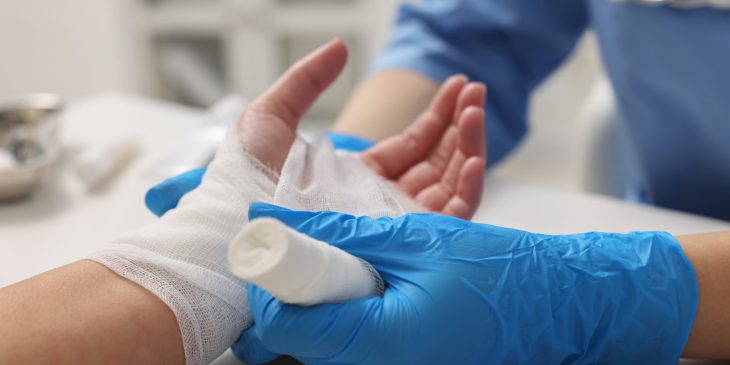A University of Pittsburgh research team is embarking on a project to study wound care in Ukraine with funding from the Medical Technology Enterprise Consortium, a nonprofit organization managed by the U.S. Department of Defense (DOD).
The project, “Characterization of Wound Infection and Its Electroceutical Management in Civilian and Military Wounds in Ukraine,” will receive funding of almost $1.9 million over two years to study the effectiveness of a wireless electroceutical dressing (WED) — a bandage that generates an electrical field — in treating traumatic wounds sustained during combat in both military members and civilians.
Since isolated environments and transportation challenges can delay treatment at medical facilities, infection is a major concern for wounds and burns sustained during military conflicts.

Dr. Chandan K. Sen
“Combat wounds are prone to hostile biofilm infection and multi-drug resistance, which means that the usual arsenal of antibiotics and antimicrobials is ineffective,” said Dr. Chandan K. Sen, principal investigator of the study and professor of surgery and plastic surgery at Pitt.
The WED is a flexible fabric bandage made of polyester embedded with silver and zinc dots. When activated by the moist environment of a wound, the metal array produces a low electric field that generates reactive oxygen molecules that disrupt bacterial biofilms and stimulate wound healing. Sen and his colleagues previously showed that antibiotic-resistant pathogens can rapidly become antibiotic-sensitive in response to the WED. The dressing can be self-applied without any special training and does not require an external power source.
“This is a simple, portable and shelf-stable bandage that protects the wound by preventing and disrupting biofilm infection. It could be the difference between life and death for civilians and service members who are injured in a war setting,” added Sen, who is also chief scientific officer of UPMC Wound Healing Services and director of the McGowan Institute for Regenerative Medicine.
Previously cleared by the U.S. Food and Drug Administration for civilian use, the WED has not been tested in a war setting. Sen and his team will address this gap by examining how well the WED inhibits multi-drug-resistant microbes and promotes wound closure compared to standard of care at three sites in Ukraine.
The study will also provide insights into the practical use of the dressing in an active combat zone. Feedback from the Ukrainian sites will help the researchers determine whether improvements to the WED are required for optimal use in such a setting.
“Better management of infections through the use of this WED could result in faster healing and fewer complications for wounded service members, helping them return to duty earlier,” said Sen. “The results of this trial are important for enhancing military health and could have direct impacts on future U.S. military wound care.”
Pittsburgh-based coinvestigators on this project are Dr. Sashwati Roy, professor of surgery at Pitt; Dr. Shomita Steiner, assistant professor of surgery at Pitt and director of scientific operations at the McGowan Institute; Dr. Ronald Poropatich, professor of medicine at Pitt and director of the Center for Military Medicine Research; and Dr. Vasyl Pastukh, postdoctoral associate in orthopaedic surgery at Pitt.
This effort was awarded through MTEC solicitation MTEC-24-01-MPAI and is funded by Combat Casualty Care Research Program (CCCRP) in accordance with Congressional direction to establish medical partnering with the Ukraine specified in Sec 736 NDAA 2023 and Sec 721 NDAA 2024.
To date, the CCCRP has funded research projects within Ukraine related to traumatic brain injury, hemorrhage control, traumatic stress, rehabilitation, wound management, severe sepsis and trauma registry development. The DOD CCCRP seeks to develop requirements-driven knowledge and material solutions for the care of combat-related traumatic injury during current and future conflicts.
The views and conclusions contained herein are those of the author(s) and should not be interpreted as representing the official policies or endorsements, either expressed or implied, of the U.S. Government.









